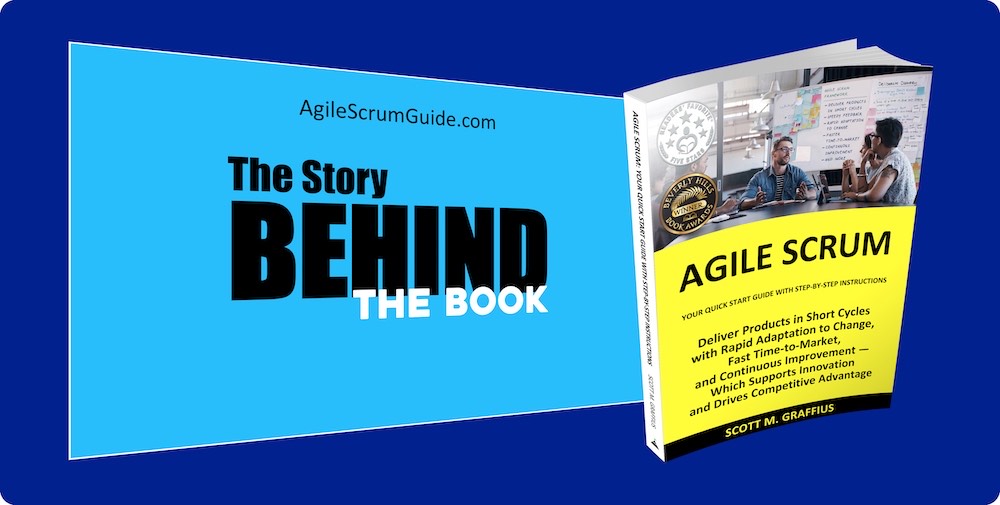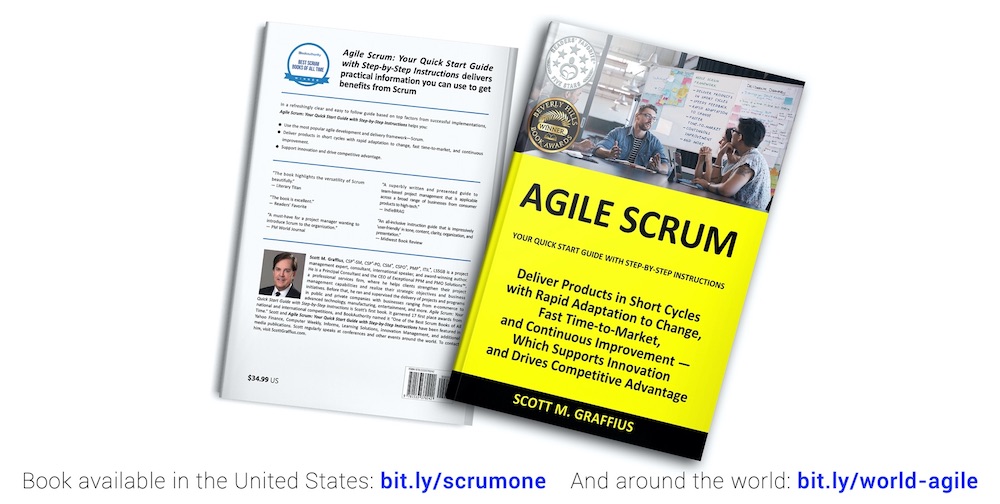The Story Behind “Agile Scrum: Your Quick Start Guide with Step-by-Step Instructions” - Agile Transformation at an Entertainment Company | Part 3
19 March 2019


Agile Workflows

The Story Behind Agile Scrum: Your Quick Start Guide with Step-by-Step Instructions — Agile Transformation at an Entertainment Company
Scott M. Graffius, CEO of Exceptional PPM and PMO Solutions™, helps companies achieve their strategic objectives and business initiatives through project management leadership. A fantastic agile transformation outcome with a client organization in the entertainment industry was the inspiration for Scott's award-winning book, Agile Scrum: Your Quick Start Guide with Step-by-Step Instructions. This is the story behind the book—told by Scott. Identifying details have been changed and certain elements are not included.
This article is the third installment of the eight-part story. If you haven't already read the earlier parts, you can find them here:

Part 3: The Environment
Highlights on the environment including roles and practices—primarily focused on the Scrum Team—follow.
I learned that the Scrum Team was composed of 16 people: one Scrum Master, one Product Owner, and 14 Development Team members. Both the Scrum Master and the Product Owner explained that they were familiar with agile, but that they had no prior work experience with agile/Scrum and no related training—except for what was provided by the value-added reseller (VAR). The Development Team consisted of 14 people: a technical architect, a UI designer, a business analyst, seven developers, three testers, and a technical writer. Eleven of the 14 members of the Development Team had no prior work experience with agile/Scrum and no related training—except for what was provided by the VAR. Of the 16 people on the Scrum Team, 15 were local (at an office in the greater Los Angeles area), and one—the Product Owner—was based out of her office in Paris, France.
Of the 16 people on the Scrum Team, two—the Scrum Master and the Product Owner—were full time on the project. All of the others were allocated about 50% on the project.
I was given a copy of the training binder left by the VAR. I was told that the contents—about 500 pages—reflected the totality of the training and reference material. The training session, led by the VAR, was attended by the Scrum Master and the all of the Development Team members. The executive vice president (EVP) attended portions. The Product Owner attended portions, listening by phone. The first page in the binder covered the Agile Manifesto, the second page was a two-column table which compared and contrasted waterfall and Scrum (e.g., waterfall freezes scope, Scrum freezes schedule), and the third page showed success rates of waterfall vs. Scrum (e.g., 29% of waterfall projects fail vs. 9% of agile projects). The remaining pages provided information about the VAR company and detailed instructions on how to use their software product. That constituted the training.
The Product Owner, Scrum Master, and Development Team reported that they followed the training and instructions provided by the VAR. I won't delineate the then-current roles further or describe all of the events and artifacts. However, some examples follow.
The Product Owner created a product vision statement and stored it in the software, but nobody else remembered seeing it.
The Product Owner created a product backlog in the software, but nobody else claimed to have seen it.
The Scrum Master facilitated a Sprint Planning event where the Development Team estimated work in terms of complexity, and the results were recorded in the software tool. It was reported that—due to the time difference—the Product Owner did not attend Sprint Planning meetings.
It was communicated that during Sprint execution, the Scrum Master would ask the Development Team if they had any notable progress; and only if the answer was yes, there was a Daily Scrum. As a result, the Daily Scrum event occurred around once or twice a week. When the meeting took place, the Scrum Master did a quick interview with each member of the Development Team and noted the results in the software tool.
I was told that the team followed the recommendation of the VAR for the sprint duration of four weeks.
The Sprint Reviews were attended by the Scrum Master, the Product Owner (remotely), all of the Development Team members, and the EVP. However, the other stakeholders did not attend the events. On average, about half of the work planned and committed to the sprint was "done." Both "done" and not-"done" items were demonstrated at the Sprint Review.
The Scrum Master reported that the team did conduct a Retrospective event at the end of each sprint and that the results were saved in the software tool. When I reviewed the information, I saw comments such as "we worked very hard" under the what went well category. Everything under the "what didn't go so well/opportunities for improvements" category were ideas for enhancement requests for the software tool. I was informed that the VAR instructed staff to convert everything that didn't go well into a suggestion for a future general release of the software or a request for a custom enhancement of the software.
None of the work from any of the sprints was released.
The Story Behind Agile Scrum: Your Quick Start Guide with Step-by-Step Instructions — Agile Transformation at an Entertainment Company continues with Part 4: The Options.

About Agile Scrum: Your Quick Start Guide with Step-by-Step Instructions

Shifting customer needs are common in today's marketplace. Businesses must be adaptive and responsive to change while delivering an exceptional customer experience to be competitive.
There are a variety of frameworks supporting the development of products and services, and most approaches fall into one of two broad categories: traditional or agile. Traditional practices such as waterfall engage sequential development, while agile involves iterative and incremental deliverables. Organizations are increasingly embracing agile to manage projects, and best meet their business needs of rapid response to change, fast delivery speed, and more.
With clear and easy to follow step-by-step instructions, Scott M. Graffius's award-winning Agile Scrum: Your Quick Start Guide with Step-by-Step Instructions helps the reader:
- Implement and use the most popular agile framework―Scrum;
- Deliver products in short cycles with rapid adaptation to change, fast time-to-market, and continuous improvement; and
- Support innovation and drive competitive advantage.
Hailed by Literary Titan as “the book highlights the versatility of Scrum beautifully.”
Winner of 17 first place awards.
Agile Scrum: Your Quick Start Guide with Step-by-Step Instructions is available in paperback and ebook/Kindle worldwide. Some links by country follow.
- 🇦🇺 Australia
- 🇦🇹 Austria
- 🇧🇪 Belgium
- 🇧🇷 Brazil
- 🇨🇦 Canada
- 🇨🇿 Czech Republic
- 🇩🇰 Denmark
- 🇫🇮 Finland
- 🇫🇷 France
- 🇩🇪 Germany
- 🇬🇷 Greece
- 🇭🇺 Hungary
- 🇮🇳 India
- 🇮🇪 Ireland
- 🇮🇱 Israel
- 🇮🇹 Italy
- 🇯🇵 Japan
- 🇱🇺 Luxembourg
- 🇲🇽 Mexico
- 🇳🇱 Netherlands
- 🇳🇿 New Zealand
- 🇳🇴 Norway
- 🇪🇸 Spain
- 🇸🇪 Sweden
- 🇨🇭 Switzerland
- 🇦🇪 UAE
- 🇬🇧 United Kingdom
- 🇺🇸 United States
- 🌏 More countries

Let's Connect

Connect with AgileScrumGuide.com on Facebook, Twitter, LinkedIn, Instagram, and Pinterest.
And connect with agile project management practitioner, consultant, award-winning author, and international speaker Scott M. Graffius on Twitter, Facebook, and LinkedIn.

© Copyright 2019 Scott M. Graffius, AgileScrumGuide.com. All rights reserved. This material may not be published, broadcast, rewritten or redistributed without the express written permission of Scott M. Graffius/AgileScrumGuide.com.
